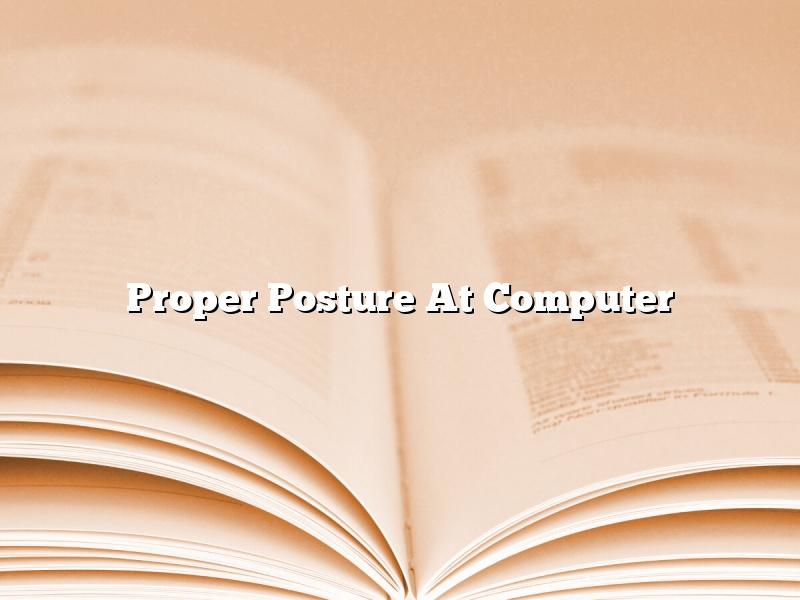When you work at a computer for long periods of time, it’s important to maintain good posture. This will help prevent pain in your neck, shoulders, and back.
Here are some tips for maintaining good posture at your computer:
1. Make sure your chair is adjustable so that you can sit with your feet flat on the floor and your elbows at a 90-degree angle.
2. Keep your head and neck in line with your spine. Don’t bend your head forward or backward, and don’t tilt it to the side.
3. Keep your shoulders relaxed and your back straight.
4. Use a keyboard and mouse that are properly positioned for you.
5. Take regular breaks to move around and stretch.
Contents [hide]
- 1 What is the correct posture when using a computer?
- 2 Why is proper posture in using computer important?
- 3 What is the proper posture and position of a typist?
- 4 Why is posture important for students?
- 5 Why posture is important in communication?
- 6 What are the 7 proper keyboarding techniques?
- 7 What are the benefits of good posture?
What is the correct posture when using a computer?
When you use a computer, you should sit up straight with your shoulders back and your eyes looking straight ahead. You should also keep your feet flat on the ground. This is the correct posture to avoid back and neck pain.
Why is proper posture in using computer important?
Computer users have long been admonished to sit up straight and avoid slouching, and for good reason. Poor posture when using a computer can lead to a number of problems, including neck and shoulder pain, carpal tunnel syndrome, and vision problems.
Neck pain is one of the most common problems associated with poor computer posture. When you slouch, your neck is forced to bend forward, which can lead to tension headaches and neck pain. To avoid neck pain, make sure to sit up straight and keep your head in line with your spine.
Shoulder pain is another common problem associated with poor computer posture. When you slouch, your shoulders are forced to hunch forward, which can lead to tension in the muscles and ligaments in the shoulder area. To avoid shoulder pain, make sure to keep your shoulders relaxed and your back straight.
Carpal tunnel syndrome is a condition that affects the hands and wrists and is caused by pressure on the median nerve. This pressure can be caused by poor posture when using a computer. To avoid carpal tunnel syndrome, make sure to keep your wrists straight and your forearms parallel to the floor.
Vision problems can also be caused by poor computer posture. When you slouch, your head is forced to bend down, which can lead to eye strain and headaches. To avoid vision problems, make sure to sit up straight and keep your head in line with your spine.
The bottom line is that it is important to maintain good posture when using a computer. Not only will this help to prevent pain and other problems, but it will also help you to be more productive and comfortable.
What is the proper posture and position of a typist?
When you are typing on a computer, you may not be aware of the best posture and position to be in to avoid injury. Here are some tips to help you stay healthy and comfortable while you work.
The best posture for typing is to have your feet flat on the ground and your spine straight. You may need to adjust your chair height and distance from the keyboard to make this comfortable. If you are not able to keep your back straight, you may need to use a lumbar support to help.
When you are typing, your hands should be in a neutral position. This means that your wrists should be in a straight line with your forearms. You should avoid bending your wrists up or down, as this can lead to pain and injuries.
You should also keep your shoulders relaxed and your head up. This will help you avoid neck pain.
If you follow these tips, you can maintain good posture and avoid injury while you type.
Why is posture important for students?
Posture is important for students because it can affect their focus, energy, and ability to learn. Poor posture can cause pain and fatigue, which can lead to students becoming distracted and discouraged. Good posture, on the other hand, can help students feel more alert and focused, and can improve their ability to learn and retain information. There are several things students can do to improve their posture, including practicing good habits, using ergonomic furniture and tools, and doing strength and flexibility exercises.
Why posture is important in communication?
Posture is an important part of communication because it can affect the tone of your voice and the way that you are perceived by others. Good posture can make you appear more confident and assertive, while bad posture can make you look weak or unprofessional.
One of the most important things to keep in mind when it comes to posture is to stay aligned. When you’re aligned, it means that your head, neck, and spine are in a straight line. This will help you to maintain good posture and avoid slouching.
To improve your posture, try to keep your shoulders back and your chest open. This will help you to appear more engaged and interested in what the other person is saying. It will also help you to speak more clearly and with more authority.
Bad posture can have a number of negative effects on your communication. It can make you sound tired or bored, and it can also make you look unprofessional or weak.
Good posture, on the other hand, can make you appear more confident and engaged. It can also help you to speak more clearly and with more authority.
So, why is posture important in communication? Because it can affect the way that you are perceived by others, and it can also have a positive or negative effect on your speaking ability.
What are the 7 proper keyboarding techniques?
There are a variety of keyboarding techniques that can be used to improve your typing speed and accuracy. Here are seven of the most effective techniques:
1. Keep your wrists straight
When you type, keep your wrists straight and in line with your forearms. This will help to prevent pain and injuries in the future.
2. Use a light touch
When you type, use a light touch and keep your fingers close to the keyboard. This will help you to type faster and more accurately.
3. Use the correct fingers
Use your fingers to type the letters on the keyboard. For the most part, your left hand should control the letters on the left side of the keyboard, and your right hand should control the letters on the right side of the keyboard.
4. Use the correct fingers for numbers
When you type numbers, use your left hand to type the numbers on the number pad on the right side of the keyboard, and use your right hand to type the numbers on the number pad on the left side of the keyboard.
5. Use the correct fingers for symbols
When you type symbols, use your left hand to type the symbols that are on the left side of the keyboard, and use your right hand to type the symbols that are on the right side of the keyboard.
6. Keep your fingers close to the keyboard
When you type, keep your fingers close to the keyboard. This will help you to type more quickly and accurately.
7. Use the correct posture
When you type, sit up straight with your feet flat on the ground. This will help to keep you from getting tired and will help you to type more accurately.
What are the benefits of good posture?
The importance of good posture is often underestimated. It is not just about looking good, but about improving your overall health and well-being. Good posture can help to prevent back pain, improve your breathing, increase your energy levels and make you look and feel more confident.
Good posture involves keeping your spine in a neutral position. This means that your head, neck and back are in line and your muscles are relaxed. It is important to maintain good posture when sitting, standing and walking.
When you have good posture, your body is able to function more effectively. You are less likely to experience back pain, and you will have more energy and feel more confident. Good posture also helps to improve your breathing and can make you look slimmer and taller.
If you are not used to having good posture, it may take a little bit of time to get used to it. But, with a little practice, you will be able to maintain good posture throughout the day.
Here are some tips for improving your posture:
-Sit up straight with your shoulders back
-Keep your head up and your neck in line with your spine
-Tuck in your stomach muscles
-Stretch regularly
-Avoid slumping or hunching over
-When walking, keep your head up and your back straight




